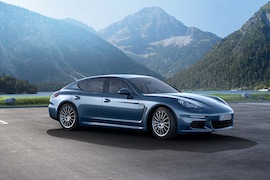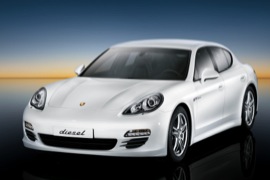PORSCHE Panamera Diesel Models/Series Timeline, Specifications & Photos
First production year: 2011
Engines: Diesel
Four years after the introduction of the first generation of the Panamera, the German car-maker unveiled the facelifted version at the 2013 Shanghai Auto Show.
The diesel version had to wait until September to be unveiled at the Frankfurt Motor Show and that made sense since Europe was the biggest market for the Panamera diesel. Apart from the visual differences, there were some technological evolutions as well.
With the option for LED headlights, Porsche Panamera stepped into a new era. Its intelligent lighting system allowed a better view of the road. The standard version was fitted with bi-xenon headlamps. The revised front and rear bumpers brought a more aggressive look for the car. The bigger side-scoops in the apron were inspired by those installed on the 911 range. A wider rear windscreen was installed on the new tailgate.
Inside, the manufacturer installed the PCM (Porsche Communication Management) for the infotainment system. It supported Apple CarPlay connectivity, but its compatibility with Android phones was limited. The tachometer was mounted in the middle of the instrument cluster, with a round TFT display on its right side, where the navigation system could have been shown, as well as other on-board computer information. The Porsche Car Connect app was available as an option.
The engine was upgraded with the help of a new, water-cooled, turbocharger. The 300 hp unit was paired as standard to an 8-speed automatic gearbox (Tiptronic S) and it was available as a rear-wheel-drive only. The self-locking rear differential helped the car to rocket from 0 to 100 kph (0-62 mph) in just 6.0 seconds flat.
In May 2011, Porsche unveiled the diesel version for its four-door Panamera. With the introduction of that version, it switched from a road runner to a long cruiser luxury sports-sedan.
By 2011, the world already accepted the diesel engines in luxurious vehicles such as the BMW 7 Series or the Mercedes-Benz S-Class. Porsche didn't want to lose that market and decided to offer a diesel version for the Panamera. Since the car was designed for long travels, a diesel engine would give it a range of over 1200 km (746 miles). After the initial shock of its regular customers, soon the orders started to pick-up.
The Diesel engined Panamera was based largely on the basic, V6 version. One of the specific problems of a diesel engine was the weight. To solve that issue, the Panamera diesel featured aluminum axles, doors, hood, wings, and trunk lid, while keeping the same silhouette. On the front fenders, two vents were used to extract the air within the wheel-well and decrease the front-lift effect. In the back, on the trunk-lid, a retractable wing was installed. It was automatically extended at speeds over 120 kph (74.5 mph).
Inside, the Panamera Hybrid designers took their inspiration from the Vertu luxury mobile phones. A four-seat layout was the only option, with a big center console that separated the driver from the other passengers. In the back, there was a decent room for adults and since it was a hatchback it could get an impressive amount of luggage. The dashboard was typical for a Porsche, with round dials and centrally-mounted tachometer. Despite its hatchback shape, the rear passengers had enough legroom and headroom.
The 3.0-liter engine was carried over from the Volkswagen group, but it was adapted to suit the Panamera needs. It was available with an 8-speed automatic (Tiptronic S) transmission fitted as standard and it was offered as a rear-wheel-drive only.

